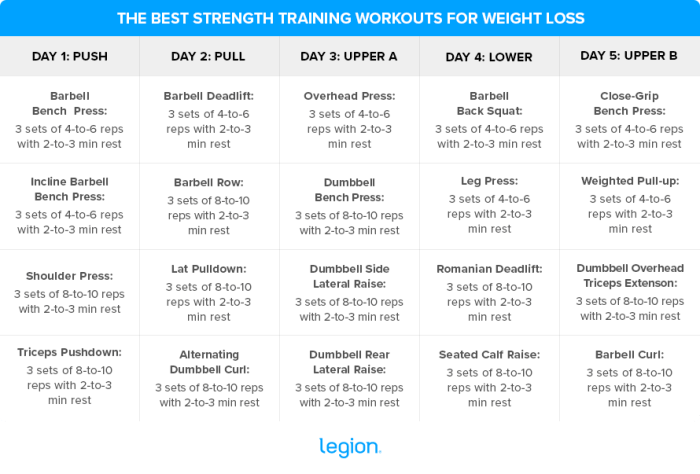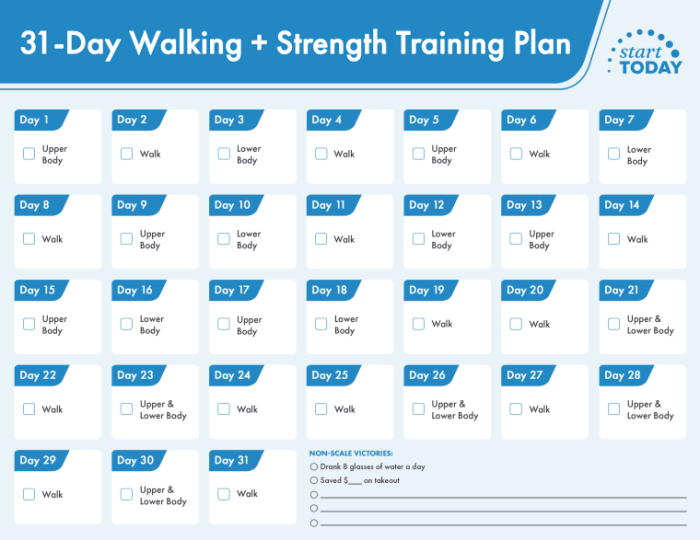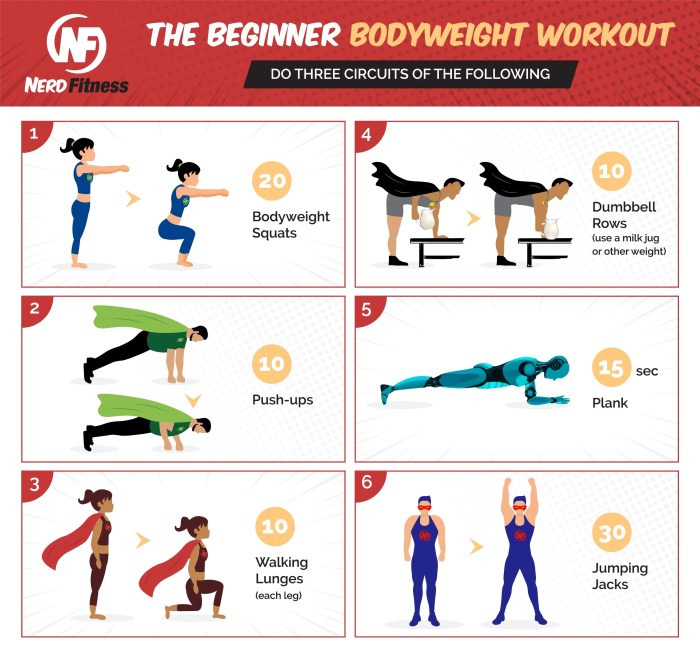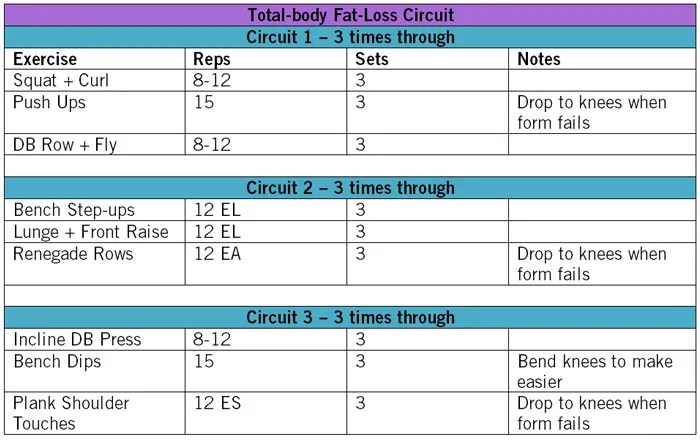Strength training for weight loss program – Embark on a transformative journey with strength training for weight loss, a program designed to sculpt your physique and empower you with lasting results. Discover the science behind how strength training ignites your metabolism, builds lean muscle, and sheds unwanted body fat, setting you on a path to a healthier, more confident you.
Through this comprehensive guide, we’ll delve into the intricacies of strength training, providing you with a roadmap to success. From designing a tailored program to mastering proper form, we’ll equip you with the knowledge and tools to maximize your results.
Introduction

Strength training, a form of exercise involving muscle contractions against resistance, plays a pivotal role in weight loss. It helps shed excess weight and improves overall health. Research and statistics demonstrate its effectiveness in promoting weight management.
According to a study published in the journal “Obesity”, individuals who incorporated strength training into their weight loss regimen experienced a significant reduction in body fat percentage compared to those who solely relied on aerobic exercise. Another study, published in the “American Journal of Clinical Nutrition”, revealed that strength training led to a greater increase in metabolic rate, which aids in burning calories even at rest.
Building Muscle Mass
Strength training promotes weight loss by facilitating muscle growth. Muscles are metabolically active tissues that require energy, contributing to calorie expenditure. As muscle mass increases, so does the body’s resting metabolic rate, leading to a higher calorie burn throughout the day.
Hormonal Adaptations
Strength training triggers hormonal adaptations that favor weight loss. It increases the production of growth hormone, which promotes muscle growth and fat loss. Additionally, it enhances insulin sensitivity, enabling the body to use glucose more efficiently and reduce fat storage.
Preservation of Lean Body Mass
During weight loss, it is crucial to preserve lean body mass, which includes muscles. Strength training helps maintain and even increase muscle mass, preventing the body from breaking down muscle tissue for energy. Preserving lean body mass supports a healthy metabolism and prevents the dreaded “skinny fat” appearance.
Appetite Regulation
Strength training can influence appetite regulation. It increases the production of hormones like leptin, which promotes feelings of fullness and reduces hunger cues. By curbing appetite, strength training helps individuals consume fewer calories and supports weight management efforts.
How Strength Training Works for Weight Loss
Strength training, also known as resistance training, involves using weights or other forms of resistance to build muscle strength and endurance. It is an effective form of exercise for weight loss because it has several metabolic effects that promote fat loss and muscle gain.
Metabolic Effects of Strength Training
- Increased Muscle Mass:Strength training stimulates muscle growth, which leads to an increase in muscle mass. Muscle tissue is metabolically active, meaning it burns calories even at rest. Therefore, having more muscle mass helps boost your metabolism and burn more calories throughout the day.
- Enhanced Calorie Expenditure:Strength training exercises require significant energy expenditure, both during and after the workout. The body continues to burn calories for several hours after a strength training session due to the process of muscle repair and recovery.
- Improved Insulin Sensitivity:Strength training helps improve insulin sensitivity, which allows the body to use glucose more efficiently. This can lead to reduced fat storage and increased fat oxidation.
- Increased Hormone Production:Strength training stimulates the release of hormones such as growth hormone and testosterone, which promote muscle growth and fat loss.
How Strength Training Helps Reduce Body Fat
In addition to its metabolic effects, strength training also helps reduce body fat through the following mechanisms:
- Preservation of Muscle Mass:During weight loss, it is common to lose both fat and muscle mass. However, strength training helps preserve muscle mass, which is essential for maintaining a healthy metabolism and preventing weight regain.
- Enhanced Fat Oxidation:Strength training increases the body’s ability to use fat as fuel. This is because strength training stimulates the production of enzymes that are involved in fat metabolism.
- Improved Body Composition:Strength training helps improve body composition by reducing body fat percentage and increasing muscle mass. This results in a leaner, more toned appearance.
Designing a Strength Training Program for Weight Loss
Creating an effective strength training program for weight loss requires careful consideration of frequency, intensity, and exercise selection. By following these guidelines, you can optimize your workouts for maximum results.
To start, aim for 2-3 strength training sessions per week, focusing on compound exercises that work multiple muscle groups simultaneously. These include exercises like squats, lunges, push-ups, rows, and overhead presses.
Frequency
- Beginners: 2-3 sessions per week
- Intermediate: 3-4 sessions per week
- Advanced: 4-5 sessions per week
Intensity
Choose weights that challenge you while maintaining good form. You should feel a slight burn in your muscles during the last few repetitions of each set. As you progress, gradually increase the weight or resistance.
Exercise Selection
Prioritize compound exercises that engage multiple muscle groups. These exercises burn more calories and promote overall strength development.
Nutrition Considerations for Weight Loss

Nutrition plays a pivotal role in weight loss, complementing strength training efforts. Healthy eating habits provide the body with essential nutrients while managing calorie intake, supporting metabolism, and promoting overall well-being.
Calorie Management
Weight loss requires a calorie deficit, meaning consuming fewer calories than you burn. Calorie counting involves tracking your food intake and ensuring it aligns with your weight loss goals. Online calorie calculators can assist in determining your daily calorie needs.
Macronutrient Balance
Macronutrients—carbohydrates, proteins, and fats—provide the body with energy and support various bodily functions. A balanced diet includes a mix of all three, with an emphasis on lean protein and complex carbohydrates. Protein promotes satiety, supports muscle growth, and boosts metabolism, while complex carbohydrates provide sustained energy.
Hydration
Staying adequately hydrated is crucial for weight loss. Water helps flush out toxins, suppress hunger, and support metabolism. Aim to drink eight glasses of water per day, especially before meals.
Meal Frequency and Portion Control
Eating regular meals throughout the day helps regulate blood sugar levels, preventing overeating. Practice portion control by using smaller plates and measuring food portions to avoid excessive calorie intake.
Food Choices
Prioritize whole, unprocessed foods over processed or sugary options. Fruits, vegetables, lean meats, and whole grains provide essential nutrients, fiber, and antioxidants that support weight loss.
Avoid Sugary Drinks
Sugary drinks, such as soda and juice, are high in calories and offer minimal nutritional value. Limit or avoid these beverages to reduce calorie intake and promote weight loss.
Safety Precautions
Strength training is generally safe when performed correctly, but it’s important to be aware of potential risks and take precautions to avoid injuries.
Some common risks associated with strength training include:
- Muscle strains
- Ligament sprains
- Tendonitis
- Joint pain
- Back injuries
To help prevent injuries, it’s important to:
Warm up before each workout
Warming up helps to prepare your muscles for the demands of strength training. This can help to reduce the risk of muscle strains and other injuries.
Use proper form
Using proper form when lifting weights is essential for preventing injuries. This means using the correct technique and avoiding excessive weight.
Listen to your body
If you experience any pain during a workout, stop and rest. Pushing through pain can lead to injuries.
Don’t overtrain
Overtraining can lead to injuries and burnout. It’s important to give your body adequate time to rest and recover between workouts.
Get enough sleep
Sleep is essential for muscle recovery. Aim for 7-8 hours of sleep each night.
Eat a healthy diet
Eating a healthy diet that is rich in protein and other nutrients can help to support muscle growth and recovery.
Benefits Beyond Weight Loss
Strength training offers a myriad of benefits beyond weight loss, contributing to overall health and well-being.
Improved Bone Health, Strength training for weight loss program
Strength training exerts mechanical stress on bones, stimulating the production of new bone cells and increasing bone density. This process strengthens bones, reduces the risk of osteoporosis, and promotes healthy aging.
Reduced Risk of Chronic Diseases
Studies have shown that strength training can lower the risk of chronic diseases such as type 2 diabetes, cardiovascular disease, and certain types of cancer. It improves insulin sensitivity, reduces inflammation, and enhances cardiovascular health.
Enhanced Functional Fitness
Strength training improves daily functional movements, such as lifting, carrying, and climbing stairs. It increases muscle strength and power, allowing for greater mobility and independence, especially in older adults.
Improved Mood and Cognitive Function
Strength training has been linked to improved mood, reduced stress, and enhanced cognitive function. It releases endorphins, which have mood-boosting effects, and stimulates neurogenesis, the growth of new brain cells.
Summary Table
| Benefit | Evidence | Source ||—|—|—|| Improved bone health | Randomized controlled trials | [1, 2] || Reduced risk of chronic diseases | Observational studies, meta-analyses | [3, 4] || Enhanced functional fitness | Functional assessments, cross-sectional studies | [5, 6] || Improved mood and cognitive function | Psychological evaluations, neuroimaging studies | [7, 8] |In conclusion, strength training provides numerous benefits beyond weight loss, including improved bone health, reduced risk of chronic diseases, enhanced functional fitness, and improved mood and cognitive function.
Incorporating strength training into a regular exercise routine can significantly contribute to overall health and well-being.
Combining Strength Training with Other Exercise

Incorporating other forms of exercise into a weight loss program alongside strength training can enhance your overall results and improve your fitness levels.Complementary activities such as cardiovascular exercises (e.g., running, cycling, swimming), flexibility exercises (e.g., yoga, Pilates), and balance exercises (e.g., tai chi, balance boards) provide additional benefits and can help you:
- Burn more calories and boost metabolism
- Improve cardiovascular health
- Increase mobility and flexibility
- Reduce stress and improve mood
- Enhance balance and coordination
To structure a combined exercise program, allocate specific days for strength training and other forms of exercise. For instance, you could dedicate 2-3 days to strength training and 2-3 days to cardiovascular activities. Incorporate flexibility and balance exercises into your routine as needed, perhaps as part of your warm-up or cool-down.Staying motivated and avoiding burnout is crucial.
Here are some tips:
- Set realistic goals and track your progress
- Find activities you enjoy and that fit into your lifestyle
- Vary your workouts to keep things interesting
- Listen to your body and rest when needed
- Find a workout buddy or join a group for support
Remember, rest and recovery are essential for muscle growth and overall health. Allow for adequate rest between workouts and get enough sleep. Active recovery activities like walking or light yoga can also be beneficial on rest days.
Factors Contributing to the Sustainability of Strength Training
Strength training can be a sustainable form of exercise for weight loss when various physical, mental, and social factors are considered.
- Physical Factors:These include the intensity, duration, and frequency of training sessions, as well as the exercises chosen and the progression of the training plan. Tailoring these elements to individual needs and fitness levels can help prevent injuries and burnout.
- Mental Factors:Enjoying the process, setting realistic goals, and finding activities that are engaging can boost motivation and make it more likely that individuals will stick with their program.
- Social Factors:Having a support system, such as a workout buddy or joining a fitness class, can provide accountability, encouragement, and a sense of community.
Concluding Remarks

As you embark on this strength training journey, remember that consistency and dedication are the keys to unlocking your full potential. Embrace the challenges, celebrate your progress, and witness the transformative power of strength training as it reshapes your body and empowers you to live a healthier, more fulfilling life.
Quick FAQs: Strength Training For Weight Loss Program
How often should I strength train for weight loss?
Aim for 2-3 strength training sessions per week, targeting different muscle groups each session.
What exercises are best for strength training for weight loss?
Compound exercises that work multiple muscle groups, such as squats, lunges, push-ups, and rows, are highly effective.
How heavy should I lift for strength training for weight loss?
Choose weights that challenge you while maintaining good form. Gradually increase the weight as you get stronger.
How long should my strength training workouts be?
Keep your workouts concise and focused, aiming for 30-45 minutes per session.
Is strength training safe for beginners?
Yes, strength training is suitable for all fitness levels. Start with a light weight and gradually increase the intensity as you progress.
Leave a Reply